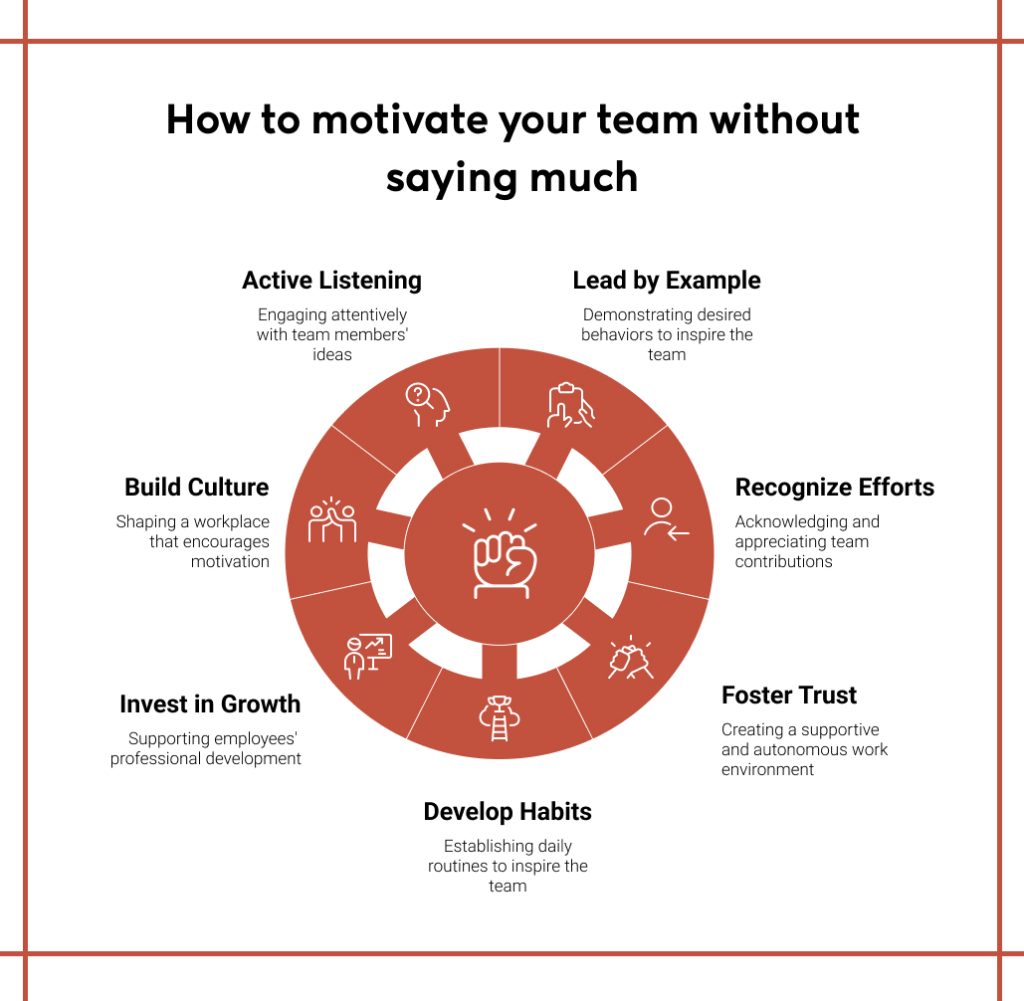Managers often feel that they need to inspire the employees with long speeches whenever their energy dips. And surely, sometimes it works briefly. But the spark fades as quickly as it appears.
Real motivation doesn’t come from long speeches; it comes from what people observe in their leaders every day. The way you act, your habits, and the environment you create speak louder than anything you say in a meeting or a speech.
This article explores the practical methods for managers to drive employee motivation in their teams without relying on lengthy speeches or frequent pep talks.

Lead by example
The simplest and easiest way to inspire a team without talking is to lead by example. If you want your employees to show up on time, you must be punctual. If you expect accountability, you should own up to your mistakes. If you wish to collaborate, you must be the first one to offer help with projects. Your actions and behavior have a greater impact than any motivation conveyed through speech.
Your daily micro behaviors also matter:
- The way you respond to stress
- The tone you use in e-mails
- How you react to a problem
When your team sees you showcasing the standards you ask of them, they also try to inculcate those virtues.
Recognize and appreciate your team’s efforts
Motivation only comes when one feels valued and recognized. Always try to appreciate the employees whenever they put in some effort. You don’t have to be dramatic, just be meaningful. Most managers reserve appreciation and praise for quarterly reviews and major presentations; instead, you should integrate them into daily interactions.
You can hand them a quick thank-you note after a challenging task, or a short message in the group chat can be more meaningful than a long speech. This quiet and authentic appreciation will make your employees feel noticed and inspire them to perform at their best.
Moreover, get to know the ways to motivate disengaged employees to increase their morale and productivity.
Foster an environment of trust and autonomy
Autonomy is one of the strongest drivers of motivation. When employees feel trusted enough to make decisions and own their work, they happily take the challenge. While micromanagement destroys motivation, if the employees get the idea that you don’t trust them, they disengage.
Instead, you need to create a culture of trust. Give clear expectations to your team and let them experiment with their methods. You need to show trust in them, even if the results are not perfect. You can tell them you believe in them, and this can be a powerful way to foster motivation among them.
Develop daily habits to inspire
Long speeches are good to hear, but some daily habits can keep you motivated. You can check in with your employee every now and then. Instead of asking about the progress, ask them if they need your support.
Don’t wait for the projects to be completed so you can celebrate. Acknowledge the efforts while the project is progressing. Try to be optimistic even in setbacks. Also, watch your body language and expressions, as they speak louder than words. When you repeat such activities in a consistent way, you can create a motivated workforce.
Invest in employees’ growth
It is a misconception that motivation is just about today’s tasks, while it is about the future as well. Employees feel energized when they know their manager cares about their development.
It is not always about great career plans or speeches about potential growth and career. It can be as simple as sharing an educational article, encouraging them to grow their skills that will help in their career, and offering feedback that nudges growth.
Show your employees that you are interested in their journey. When you feel supported in their long-term growth, they stay motivated in their day-to-day work.
Build a culture that motivates
As a manager, you need to create a culture that doesn’t solely rely on you but one that sustains itself. You need to create clear goals and a shared vision so people stay motivated and know why their work matters.
You must also encourage peer-to-peer recognition because when appreciation comes from teammates, the motivation spreads faster. You can also try to create simple rituals such as end-of-week shoutouts, morning check-ins, and project milestone celebrations. These can become natural motivators and keep your teams inspired.
Be an active listener
One of the best ways to motivate your team is to listen to what your employees have to say. Your team feels most valued when they know their voices are being heard. You can make it a habit to give your full attention in one-on-one conversations and ask relevant questions.
Even a single phrase of appreciation can go a long way in showing respect and recognition. When you listen with openness, it shows your team that you trust them, and it naturally motivates employees to contribute their best.
Final thoughts
Motivating your employees doesn’t mean standing in front of your team and delivering the perfect speech. It is more about small actions and being consistent in them. When you lead by example, build trust, invest in employee growth, and give recognition, you create a workplace where your people feel inspired and motivated.
When a workplace’s culture itself supports motivation, you no longer need to “push” your team; they can stay motivated naturally. In the end, your team will remember less of what you said and more of how you made them feel, every single day.



























No Comments